Singalila National Park
| Singalila National Park | |
|---|---|
|
IUCN category II (national park) | |
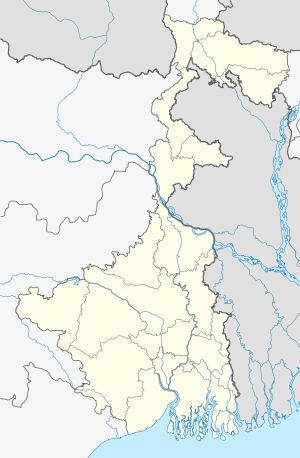 | |
| Location | Darjeeling, West Bengal, India |
| Nearest city | Manebhanjang |
| Coordinates | 27°07′N 88°04′E / 27.117°N 88.067°ECoordinates: 27°07′N 88°04′E / 27.117°N 88.067°E |
| Area | 78.6 |
| Established | 1986 |
| Governing body | Government of India, Government of West Bengal |
Singalila National Park is a national park of India located on the Singalila Ridge at an altitude of more than 7000 feet above sea level, in the Darjeeling district of West Bengal. It is well known for the trekking route to Sandakphu that runs through it.
History
The park was declared a wildlife sanctuary in 1986, and was made an Indian national park in 1992. The region had long been used as the trekking route from Manebhanjang to Sandakphu (the highest peak of West Bengal) and Phalut.
Geography
Political geography: The park is located in the Darjeeling subdivision, Darjeeling district, West Bengal, India. It is bordered on the north by the state of Sikkim and on the west by the country of Nepal.
Physical geography: The park is part of the Eastern Himalayas. The Singalila Ridge, which runs roughly North to South and separates Himalayan West Bengal from the other Eastern Himalayan ranges to the west of it. The two highest peaks of West Bengal, Sandakphu (3630 m) and Phalut (3600 m), are located on the ridge and inside the park. River Rammam and River Sirikhola flow through the park.

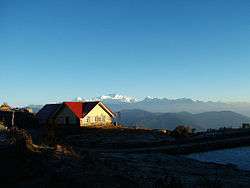
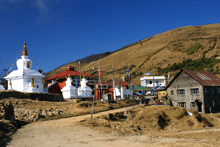
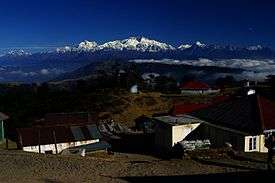
Human history
The park has no significant history of human settlement. However, small settlements have grown up along the trekking route to Sandakphu and Phalut. There is a reasonably large village at Kala Pokhri, around the lake of the same name. The Singalila Ridge was used as an approach route by the first documented mountaineering team which unsuccessfully attempted to climb Kanchenjunga in 1905. The team was led by Jules Jacot-Guillarmod and the famous occultist Aleister Crowley.
Natural history
Biomes
The national park falls in the Indomalaya ecozone, and the biomes corresponding to the ecozone which are present in the park are:
- Eastern Himalayan subalpine conifer forests of the Temperate coniferous forests biome
- Eastern Himalayan broadleaf forests of the Temperate broadleaf and mixed forests biome
- Himalayan subtropical pine forests of the Subtropical coniferous forest biome
The subtropical biome roughly exists in the altitude range of 1800 to 3000 m, and the temperate biome exists in the altitude range of 3000 m to 4500 m.

Flora
Thick bamboo, oak, magnolia and rhododendron forest between 2000 and 3600 m cover the Singalila Ridge. There are two seasons of wildflower bloom - one in spring (March and April) when the rhododendrons bloom, and another in the post-monsoon season (around October), when the lower forests bloom (Primula, Geranium, Saxifraga, Bistort, Senecio, Cotoneaster and numerous orchids). Sandakphu is known as the "mountain of poisonous plants" due to the large concentration of Himalayan cobra lilies (Arisaema) which grow there.
The plant life has been surveyed in 2001.[1]
Fauna
Mammals: The park has a number of small mammals including the red panda, leopard cat, barking deer, yellow-throated marten, wild boar, pangolin and pika. Larger mammals include the Himalayan black bear, leopard, clouded leopard, serow and takin. Tigers occasionally wander into the area, but do not have a large enough prey base to make residence in these forests feasible.
Birds: The park is a birder's delight with over 120 species recorded including many rare and exotic species like the scarlet minivet, kalij pheasant, blood pheasant, satyr tragopan, brown and fulvous parrotbills, rufous-vented tit, and Old World babblers like the fire-tailed myzornis and the golden-breasted fulvetta. The park is also on the flyway of many migratory birds.
Reptiles and amphibians: The endangered Himalayan newt frequents the region and congregates around the lakes of Jore Pokhri and Sukhiapokhri and nearby lakes to reproduce. Jore Pokhri and Sukhiapokhri are within 20 km of the park boundary and are protected wildlife sanctuaries.
Conservation issues
The major issues at the park are trash collection on trekking routes and ensuring minimal damage of flora by trekkers, as flora at such high altitudes tend to grow really slowly. Grazing of yak and cattle from neighbouring villages can also be a problem. Forest fires can be a threat to the park, especially in spring when the accumulated debris from winter can be a hazard. A forest fire swept through the park on 6 March 2006.
Even though the national park has a resident red panda population of only about 20-25 members, Project Red Panda (funded by the Central Zoo Authority) chose Singalila National Park for reintroduction of red pandas from its captive breeding program at the Padmaja Naidu Himalayan Zoological Park in Darjeeling, mainly due to reasons of proximity. Two females, Sweety and Milli, were released in November 2004. Milli was killed by a leopard, but Sweety adapted to the wild and gave birth to an offspring - the first such successful re-entry for red panda.
The reintroduction was filmed by noted Indian filmmakers Rajesh Bedi and Naresh Bedi. The documentary, named Cherub of the Mist, won the Best Conservation and Environmental Film at the 29th International Wildlife Film Festival in Montana.
Park-specific information
The park is a camper's delight as it is largely free of vicious animals and snakes, making it the most popular family camping destination in the Eastern Himalayas. The two seasons to visit the park are in spring (March–May) and post monsoon (mid-September to early December). The park is closed to tourists from June 16 to September 15 every year on account of the monsoons.
Activities
Trekking and camping : The trek along the Singalila Ridge to Sandakphu and Phalut is one of the most popular ones in the Eastern Himalayas, due to the grand vistas of the Kangchenjunga range, and the Everest range which can be seen from the ridge, and also for the seasonal wildflower blooms and birding. Treks begin at Manebhanjan which is 51 km (1.5 hours by road) from Darjeeling. The trekking routes inside the national park have 4 legs or stages.
- Manebhanjan to Meghma (2600 m): This is a 4-hour trek through the lower forest
- Meghma to Gairibans (2621 m): There are two alternative trekking routes. Both go via Tonglu (3070 m) and Tumling (2900 m). The boundary of the national park passes though Tomling and a checkpost is located there. From Tumling, a shorter trail cuts through Nepal and Jaubari (2750 m).
- Gairibans to Sandakphu (3636 m): This is a steep 4 hour climb up. Roughly halfway up the climb is the village of Kala Pokhri (3186 m).
- Sandakphu to Phalut (3600 m): This is the most pristine stretch of the trek, offering great views of Kanchenjunga and Mt. Everest. It is a one-day trek via Sabarkum (3536 m) covering 21 km. But the main problem of this Sandakphu-Phalut route is there is no water source in between so the trekker have to carry enough water to reach phalut.
The descent from Sandakphu can be accomplished in several ways:
- Retracing the way back to Manebhanjan.
- A steep descent to the village of Sirikhola on the banks of the River Sirikhola, via Gurdum (2300 m), and from there to Rimbik.
- There is now a 4WD motorable road to Sandakphu, so one can hire a cab down to Manebhanjan and Darjeeling via Tomling and Tonglu if needed. The drive on the gravel road, however, is very arduous.
The descent from Phalut can also be accomplished in several ways:
- Retracing the way back to Manebhanjan.
- A descent down to Sirikhola along high altitude meadows which have seasonal blooms. The descent is via Sabarkum and the abandoned village of Molley. A further trek leads one to the scenic village of Rimbik, which is motorable.
- The most popular descent is via the villages of Gorkey (on the banks of the River Rammam) and Samanden down to the village of Rammam. The trail then leads to Rimbik, and is shorter than the route via Sirikhola.
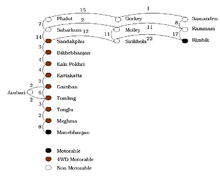
Birding: The Singalila National Park is one of the most popular birding spots in the Eastern Himalayas, since it attracts a large number of birds due to its seasonal blooms. Blooming seasons are the best times to see birds.
Lodging
Sailung Tea House is a small cozy place to stay while at Meghma. There are two roomed guest houses and trekkers' huts at Tonglu, Gairibans, Sandakphu, Phalut, Kala Pokhri and several other locations in the park, run by the Darjeeling Gorkha Hill Council. Numerous guest houses and lodging are available at Manebhanjan. The preferred way to visit the park is to stay in Darjeeling and camp inside the national park.
Approach
- Nearest airport:
- Bagdogra Airport, West Bengal
- Gangtok Helipad, East Sikkim district, Sikkim
- Nearest railhead:
- narrow gauge: Ghum, West Bengal
- Standard Gauge: New Jalpaiguri, West Bengal
- Nearest highway: NH 31A (Sivok-Gangtok) passes through Darjeeling (which is 1.5 hours by car from Manebhanjan)
- Nearest town: Manebhanjan - the access point for Rimbik and Tumling, the gateways to the park
- Nearest city: Darjeeling
How to reach
By road: Singalila National Park is well connected by road. But the roads are circular and the journey can feel like wave motion.
The road route from Siliguri
Siliguri > Sukna > Rangtong > Kurseong> Tung > Sonada> Ghoom> Manebhanjan > Tonglu - 90 km.
By rail: The nearest railway station of is Ghoom Railway Station 31 km from Tonglu (entry point to the Singalila National Park).
By air: Singalila National Park is located 13 km from Bagdogra Airport in Bagdogra. That is the nearest airport, but by road it is less than 100 km and takes 3 to 4 hours.
Films
References
- ↑ Das, A.P.; Ghosh, Chandra (March 2011). "Plant wealth of Darjiling and Sikkim Himalayas vis-à-vis Conservation". NBU Journal of Plant Sciences. University of Bengal. 5 (1): 25–33. Retrieved 18 December 2014.
- ↑ http://theindia.info/SingaliLaInTheHimalaya
- "Eastern Himalayan subalpine conifer forests". Terrestrial Ecoregions. World Wildlife Fund. Material from the following book:
- Wikramanayake, Eric; et al. (2002). Terrestrial Ecoregions of the Indo-Pacific: A Conservation Assessment. Washington, D.C.: Island Press. ISBN 1-55963-923-7.
External links
| Wikimedia Commons has media related to Singalila National Park. |
- Cherub of the Mist, a documentary